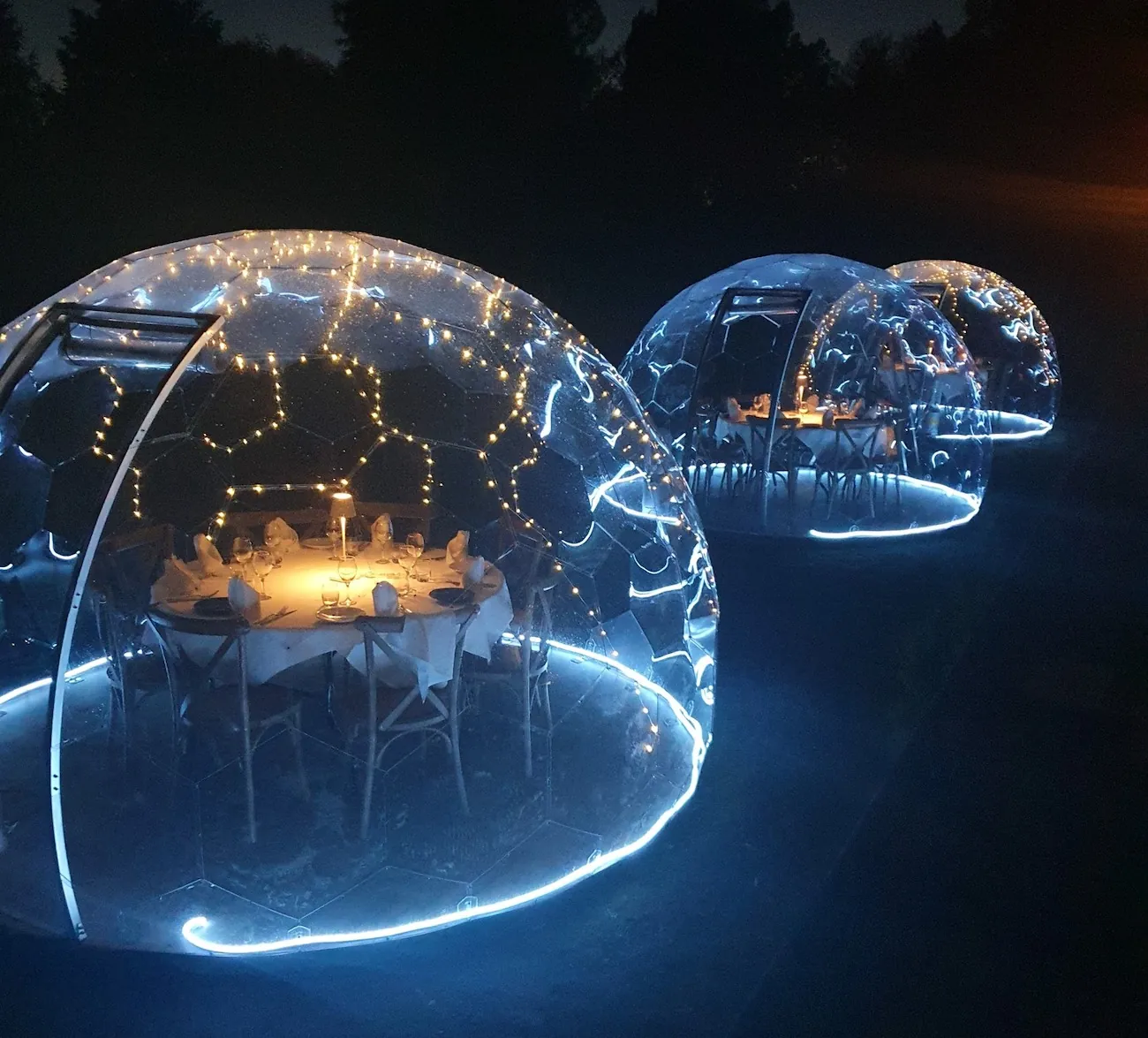“It’s beautiful… but how durable is it?” As you may know, Hypedomes are frameless, self-supporting geodesic dome structures made out of solid polycarbonate. In our completely clear version, they look beautiful, very light and almost fragile. For this exact reason, we’re often asked whether Hypedomes can withstand strong winds…

Let’s start with a little science – the strength of a geodesic dome comes from its truss-like structure that distributes stress and any applied forces throughout its entire surface. This makes the dome able to tolerate heavy wind loads for its size. Read on to find out more about the structure of geodesic domes and how we tested Hypedome’s wind resistance with great results.
Table of contents:
- The Exceptional Strength of Geodesic Domes
- Putting Hypedome Through its Paces with Wind Tunnel Testing
- The Wind Tunnel at the Institute of Aviation
- Building Our Geodesic Dome in the Wind Tunnel
- The Control Room at the Institute of Aviation
- Conducting Hypedome’s Wind Resistance Tests
- Research Report and Results
The Exceptional Strength of Geodesic Domes
Did you know the very first geodome was built in the 1920s in Jena, Germany, to house a Carl Zeiss planetarium? However, it was American inventor and architect, Buckminster Fuller, who made them popular twenty years later. He adapted the dome design for all kinds of uses, including dwellings, auditoriums, weather observatories, radar stations, storage facilities and more.

Fuller realised that domes offered remarkable strength and durability for their weight. Their triangulated and hexagonal surfaces provide very stable structures, and as hemispheres, they enclose the greatest volume for the least amount of surface area. As a result, domes offer much more efficient use of materials compared to traditional buildings.
A Storm-proof Solution
So… we already knew that our Hypedome’s wind resistance is excellent. Not only because geodesic domes are very durable by nature but also because we carry out thorough engineering calculations for all domes in our offering. And, long before we even launched our Hypedomes, we put them to the test in all sorts of weather conditions, including strong winds in highly exposed spaces.
The tremendous strength of Hypedomes has been further confirmed by several of our customers. In early 2022, Storm Eunice hit the UK – one of the most powerful storms to impact the south coast of England since the Great Storm of 1987. It even set a new record for the fastest wind gust recorded in England. Eunice caused much damage to buildings and structures nationwide. In London, for instance, large sections of the O2 Arena’s fabric roof were torn completely away.
At that time, our customer, Colin from Kent, sent us this message about his dome’s wind resistance:
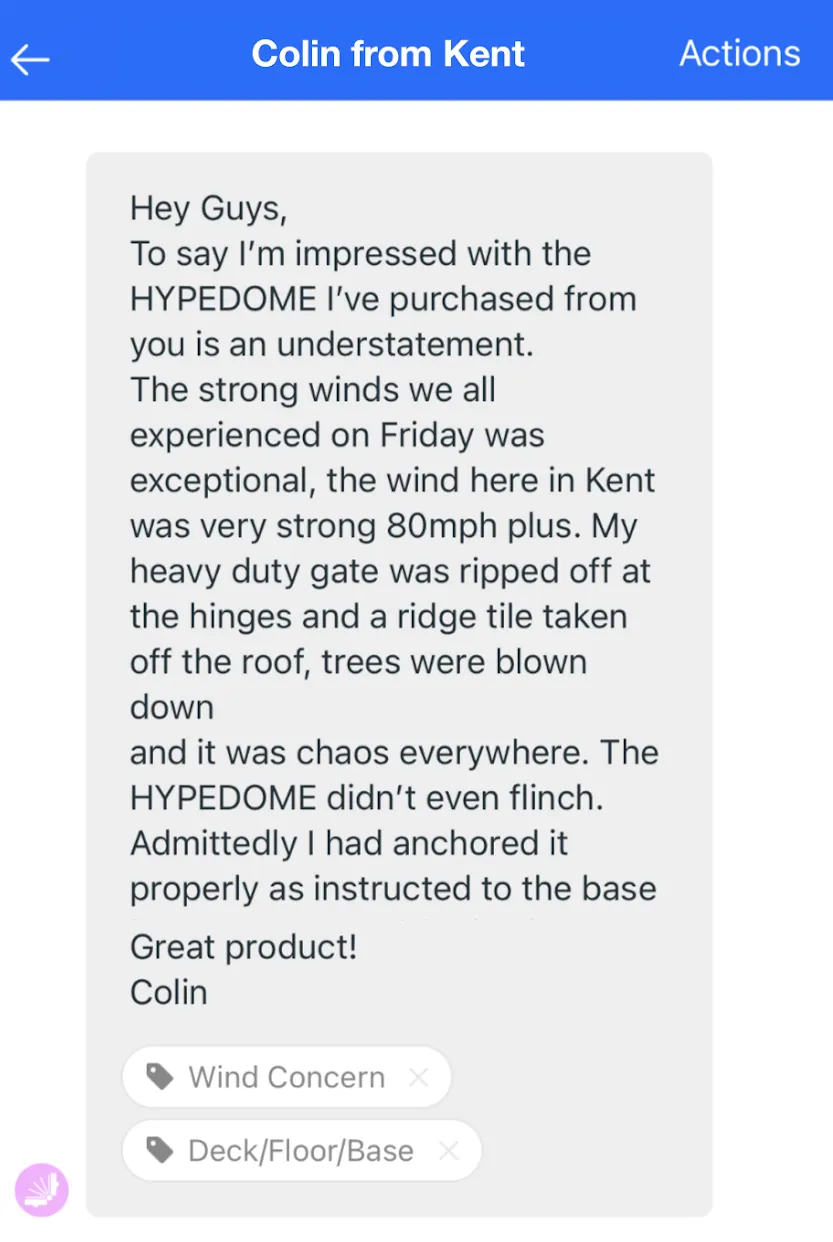
Colin wasn’t the only one to offer a Hypedome wind resistance report. Milli from Tribe Yarns Life, who installed her Hypedome on a houseboat on the River Thames in London, shared on Instagram how it fared during Storm Eunice:

And here’s some feedback we’ve received from other customers on various windy occasions:
“Charlene and I sat in it [the dome] last night, we had very strong winds, and it didn’t budge. We love it, we sent a few photos to family and friends last night, and it sounds like we will be having a few more visitors over the holidays.” – Mike from Brooklyn, MI, USA.
“Whether it’s locals that want to enjoy the outdoors and stay away from the 50-mile-an hour wind, or if visitors just want a fun place where they can stop and read a book or eat a quick lunch before they head into Yellowstone National Park, it’s an option really for anybody and everybody.” – Ryan Hauck, Executive Director of the Park County Travel Council for Cowboy State Daily.
“It’s amazing and so robust. We had hail, gale-force winds, and heavy rain all in one day, and it was as if nothing was happening outside — amazing.” – Hip Hip Events from Bristol, UK.
“Our Hypedome, built in April 2020, hasn’t had any issues with wind. We are in the Scottish borders and got hit hard by Arwen last year too.” – Chris from Scotland.
Putting Hypedome Through its Paces with Wind Tunnel Testing
Even with all the previous testing and customer feedback, we still wanted to see how our Hypedomes behave in an extreme wind scenario – just as Fuller did in the 1950s when he carried out a durability test on an anchored dome. (Fuller found that the dome successfully withstood – without damage – a day-long mighty propeller blast from the twin 3.000 horsepower engines of an anchored aeroplane.)
As we didn’t have access to an anchored aeroplane, we opted for an even more scientific approach and carried out a day-long wind tunnel test to precisely figure out our dome’s wind resistance.
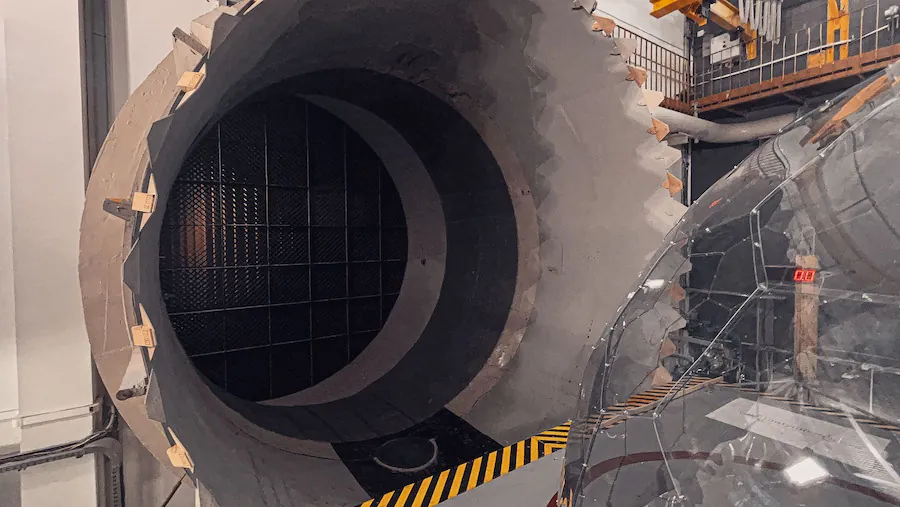
What’s a wind tunnel we hear you ask? A wind tunnel is a large testing facility used to study the effects of air moving over an object, such as an aeroplane wing, a car body or… in our case, a dome structure. It’s basically a long, narrow chamber through which air is blown at various speeds, simulating the conditions the test object would experience in flight, in motion or when exposed to wind.
Researchers use wind tunnels to test models of aircraft, automobiles, buildings, and other structures impacted by air flow. Formula 1 teams use wind tunnels in an effort to create the most aerodynamic racing car, and professional ski jumpers use them to hone their jump technique.
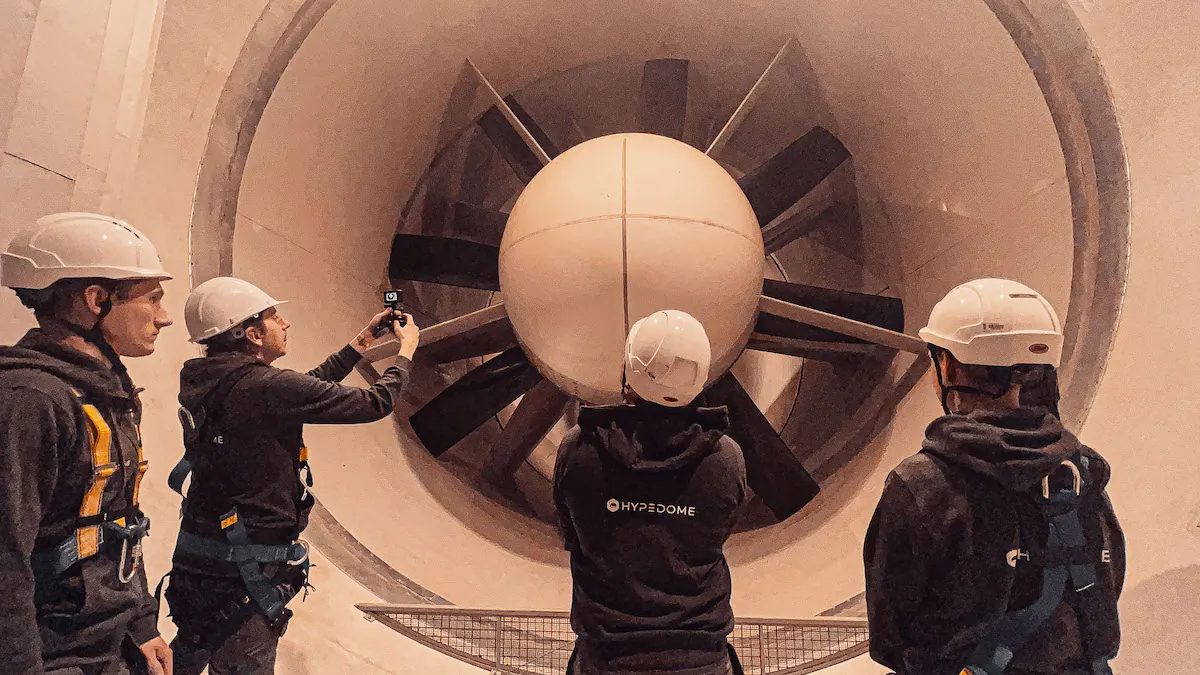
Our mission was to test how durable our Hypedome S is against strong winds. We didn’t want to test a scaled-down model – rather the actual product at a 1:1 scale – one of the same models we send to customers.
The Wind Tunnel at the Institute of Aviation
It wasn’t easy to find a tunnel in Europe with a testing bed that would be large enough to take the Hypedome S. Still, we eventually found one at the Institute of Aviation in Warsaw, Poland, which is part of the Lukasiewicz Research Network.
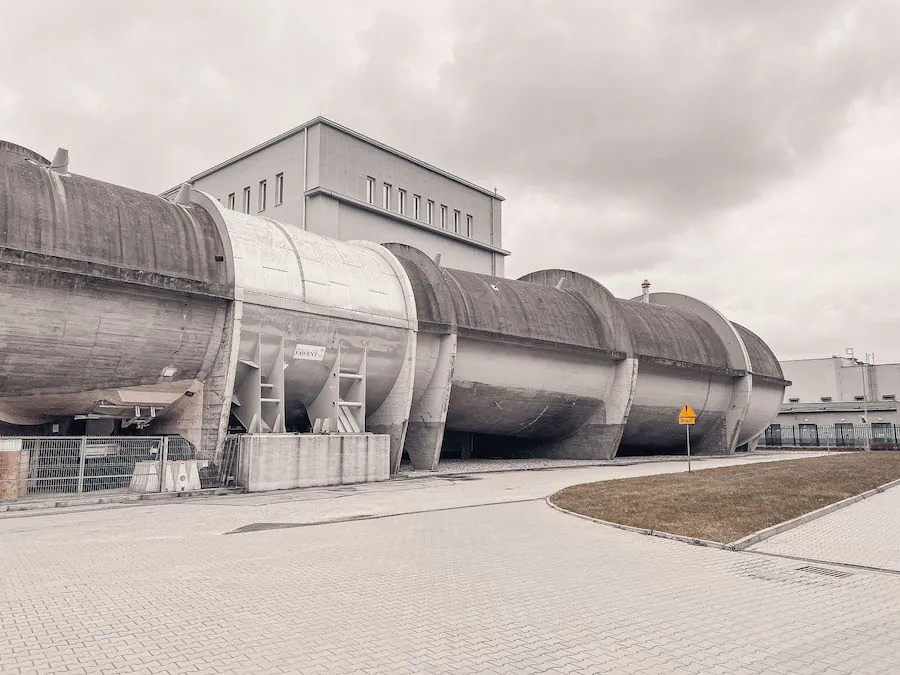
Their tunnel offers a continuous closed circuit operation in a 5 m (16.4 ft) diameter space. It’s powered by a 5.6 MW motor and achieves airflow speeds of up to 90 m/s (295 fps), which makes it one of the world’s leading aerodynamic tunnels for so-called ‘low speeds’ (‘low’ meaning subsonic speed, which can still be extremely fast).

We must admit – the tunnel was breathtaking! We were lucky enough to do a complete walkthrough of the circuit. Its futuristic, concrete, raw look, paired with the huge propeller of a wind turbine, made us feel like we were on the stage set of the Blade Runner movie.
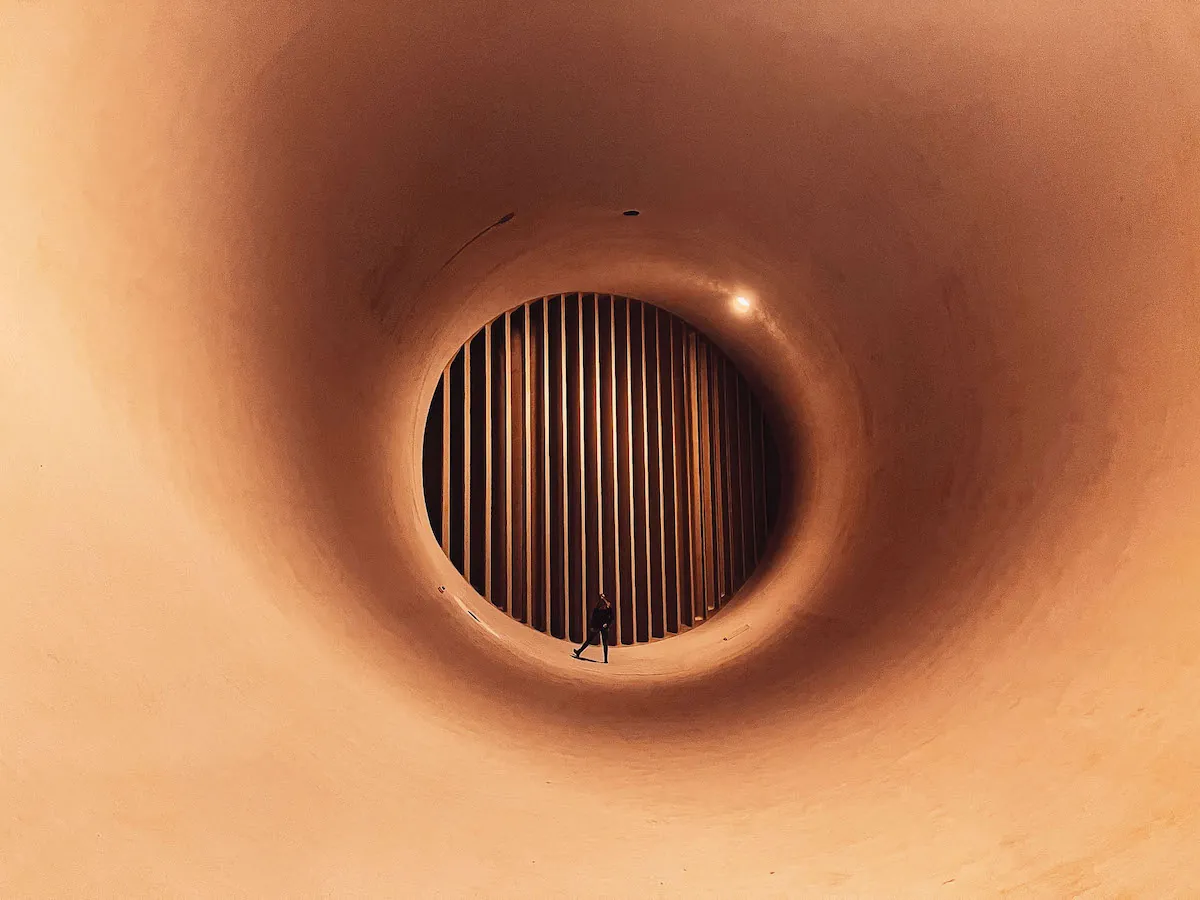
Fun fact – the tunnel has been used as a stage for music video clips and also as the setting for a fashion show.
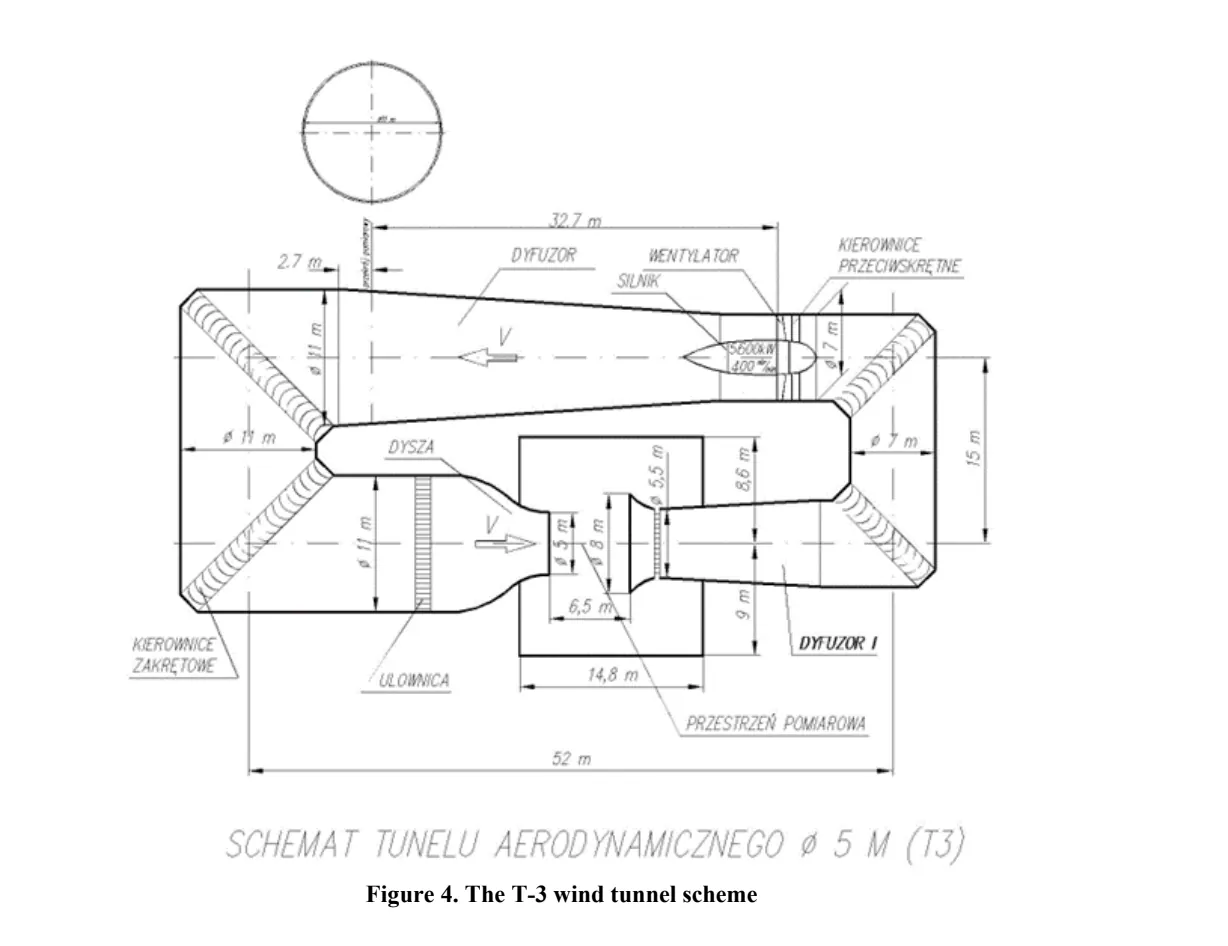
Building Our Geodesic Dome in the Wind Tunnel
Can you imagine building a Hypedome in a wind tunnel? It was an extraordinary experience. The testing bed where we mounted the geodesic dome was placed 5 m (16.4 ft) above the ground and centred between two open parts of the tunnel. For that reason, our brave Hypedome team had to wear safety harnesses and hard hats for the duration of the build.
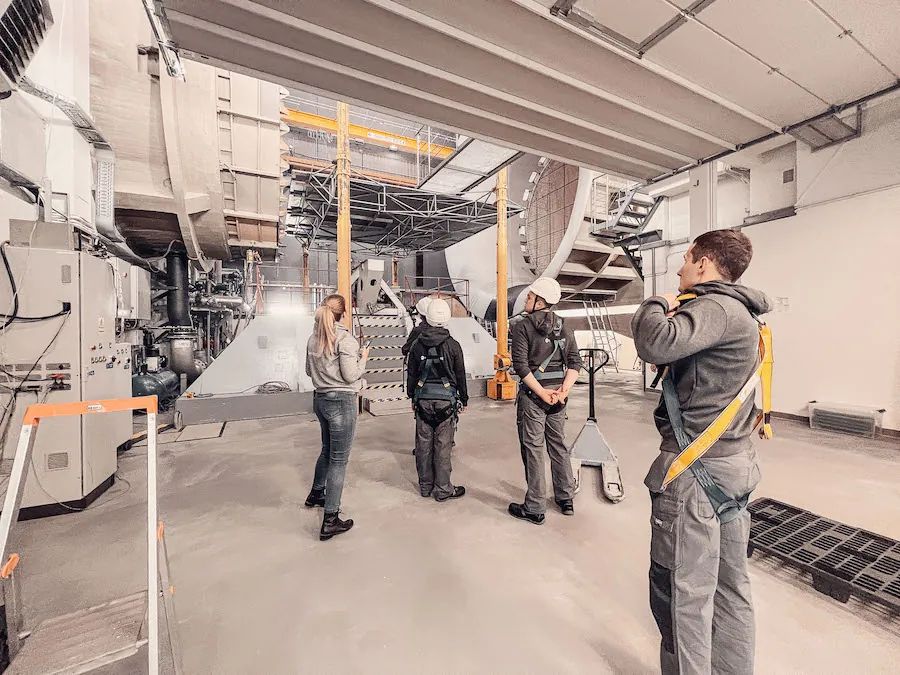
Protective gear was required for health and safety reasons due to the working space being on an elevated platform. Of course, when building a Hypedome kit yourself in typical conditions – on ground level – there’s absolutely no need to wear safety equipment.

All of the Hypedome S Clear pieces were lifted by a crane to the working platform and after about five hours of assembly, the dome was completed and secured to the testing bed with deck screws.
Anchoring the Dome
For this test, we used anchoring equipment that comes with every standard Hypedome geodome kit. It consists of 19 anchoring feet – a mix of polycarbonate and stainless steel L-shaped brackets – which were connected to the dome with stainless steel screws and fixed to the testing bed with deck screws.
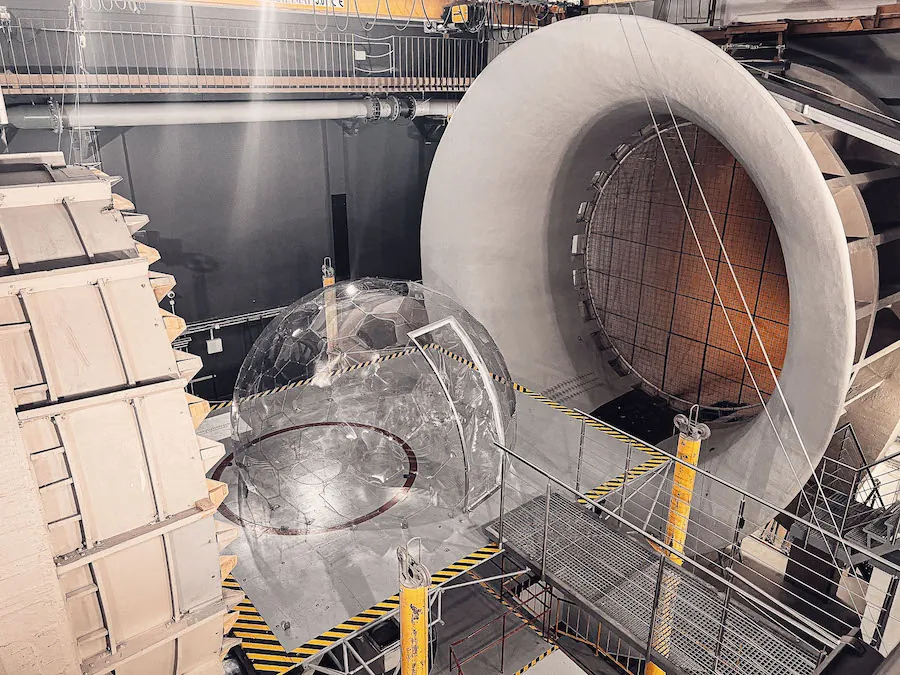
In a separate experiment, we also tested our heavy-duty anchoring kit, which comes with all stainless steel L-shaped brackets.
The Control Room at the Institute of Aviation
If you’ve been lucky enough to visit the Kennedy Space Center (or if you’ve watched the Apollo 13 movie), you’ll have a good idea of what a space flight control deck looks like. The secure control room at the Aviation Institute feels very similar, with more than a dozen screens filled with data, graphs and multiple camera views from different angles. It’s situated a few metres from the platform, overlooking the entire testing area.

Ida, our Product Manager, pretending to be launching the wind tunnel turbine
Conducting Hypedome’s Wind Resistance Tests
The Hypedome team, together with the Institute of Aviation’s team of experts, gathered in the control room where we observed all the tests.
First, we carried out a low-speed test with a fog generator that allowed us to actually see the wind flow around the dome. This told us how aerodynamic the dome was and how the air flowed smoothly around the shape of the hemisphere, producing no turbulence at all.
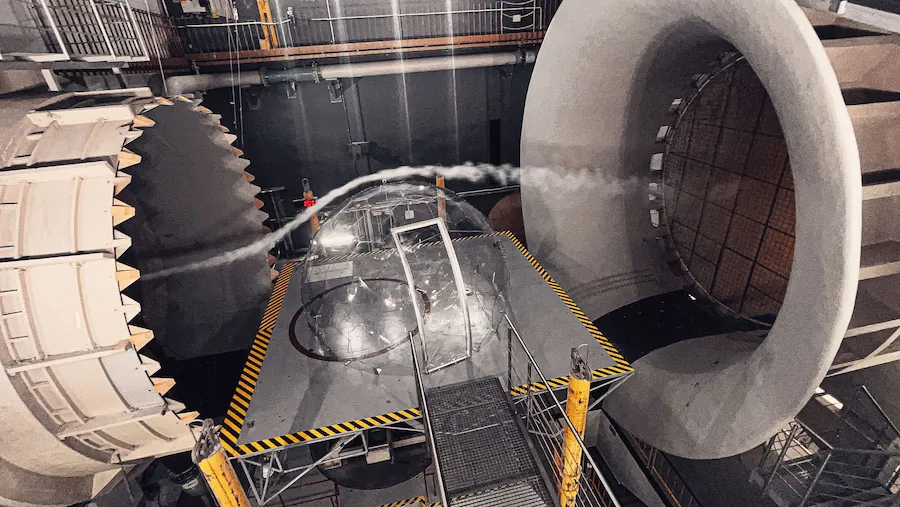
After the air-flow visualisation runs, we did a range of stress tests for wind speeds ranging between 60-120 km/h (37-74 mph). The dome stood completely still and didn’t seem to notice the severe conditions around it.
Finally, we executed several repeated tests for sustained wind speeds of 100-150 km/h (62-93 mph). The tests were carried out with standard anchoring and heavy-duty anchoring. In both cases, the dome remained perfectly still. It didn’t move an inch, and all parts and panels were completely intact.
You can see for yourself how the Hypedome handled those high-speed wind tests. In the video below, check out the current wind speed on the red-digit anemometer – it’s displayed in km/h. The slight vibrations of the dome that you’ll notice were caused by the entire platform vibrating, not the dome itself. Even when empty, the whole platform (measuring 5m x 6.5m / 16.4 ft x 21.3 ft) moved a little when exposed to high wind loads.

Research Report and Results
The dome’s wind resistance tests were concluded successfully, meaning the Hypedome S Clear passed those real-life wind speed tests. This positive outcome has been confirmed by the official report from The Aerodynamic Research Laboratory, part of the Lukasiewicz Research Network at the Institute of Aviation.
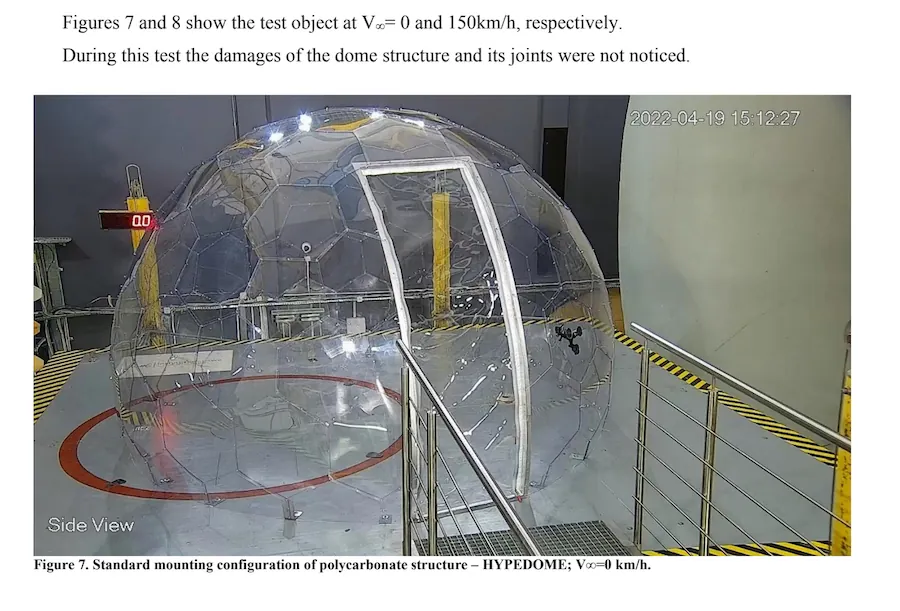
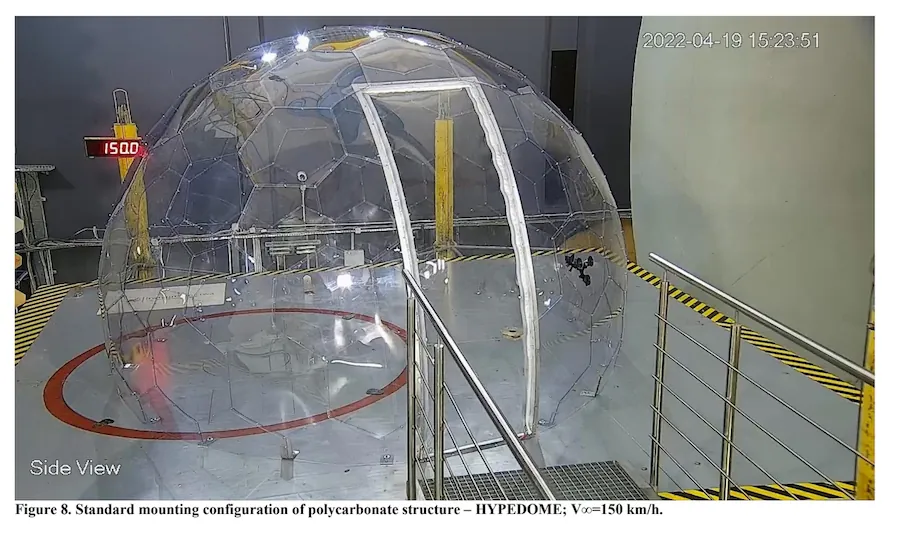
Coming back to the original question about Hypedome’s durability, we’re happy to confirm that our domes will stand up to harsh weather conditions – like strong winds. This is provided they’re anchored properly, have all the openings closed and are well maintained, as we recommend.
Not only engineering computations and customer feedback allow us to be confident about our product. It’s also the positive result of rigorous testing we’ve undertaken in an enormous wind tunnel.
While the shape of all geodesic domes provides similar aerodynamic properties, it’s the construction and quality of used materials that make the difference. Choosing Hypedome you choose a quality that has been thoroughly tested and we can prove it.
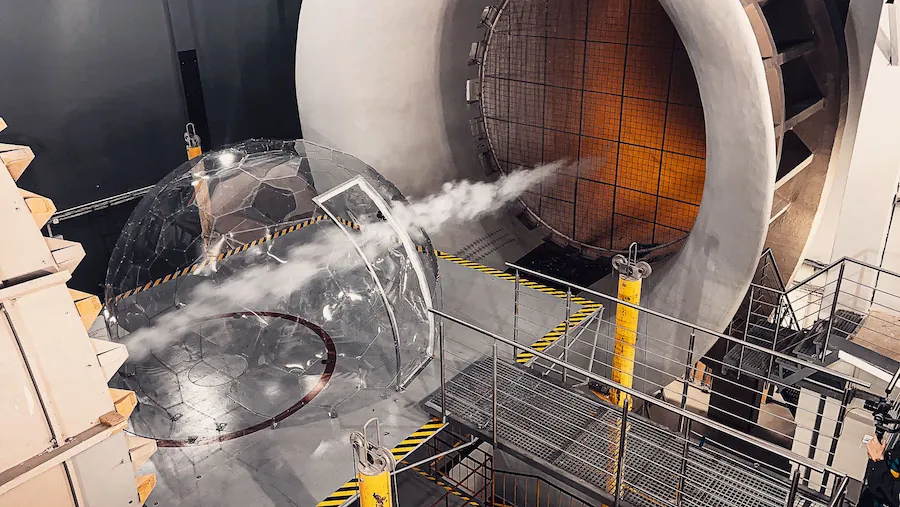
So, when it’s blowing a gale outside, you don’t need to worry about your beautiful Hypedome. (Watch out for your other garden structures though!)
*Disclaimer:
Hypedomes are very robust, lightweight structures designed to be used outdoors (for example, as a garden pod) and withstand strong winds of 120 km/h (74 mph). It is the user’s responsibility to properly secure the dome and ensure it remains in good condition. We can’t guarantee the safety or performance of the dome if it’s not properly secured or maintained.
To minimise the risk of your Hypedome being damaged by the wind, please do the following:
• Make sure all L-shaped brackets are anchored properly, and the bolts or stakes remain tight.
• Check if the window panel (if you have one) and the zip door are firmly in place and securely closed – it’s important to keep your Hypedome closed when not in use.
• Regularly inspect the dome for any damage and perform selective tests of bolt tightness.
• Follow other guidelines from the Hypedome’s Maintenance Guide.
